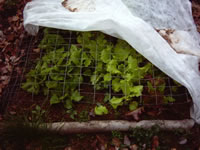|
When planting Lettuce it is very important to select cultivars that are appropriate for the current growing season.
Plant rows of several types at different intervals throughout the year for a continuous supply!
Growing Requirements for Lettuce Plants
Lettuce grows best when temperatures are between 50° and 68° during the day and cooler at night.
It should be grown in full sun or in light shade if the weather is hot.
Lettuces should be planted in fertile, moisture retaining, light soil with a pH of 6.5-7.0.
Fertilize lightly prior to planting Lettuce, and lightly again every 3 weeks, using a high nitroger fertilizer.
The planting bed should be kept moist at all times, but the most critical period for watering is the 7-10 days before harvest
at which time your Lettuce plants are likely to bolt if the soil dries out at all.
Growing Lettuce from Seed
|
Lettuce seeds require light for germination so do NOT cover them!
Lettuce seeds can be planted directly into the garden in early spring, as soon as the soil can be worked. Plant leaf types 4"-6" apart and head Lettuce 10"-12" apart in rows spaced 12"-18" apart. A fall crop can be planted in late summer.
Plant Lettuce seeds indoors in cell packs, 4 weeks before
the last killing frost date in your area.
Maintain a temperature of 65°-70° until germination, which takes 7-10 days.
After germination, continue growing on at 55°-60° until moving to the garden.
Lettuce seedlings are subject to transplant shock,
so use care when transplanting them into the garden. |
|
Insects, Pests and Problems that Affect Lettuce
Aside from the slugs and snails that will quickly devour seedlings and mature Lettuce plants, there are several other
pests and problems that can affect, damage or destroy your Lettuce Crop.
Bacterial soft rot is often caused by overcrowding plants. It is hard to detect, because the infection develops
soft mushy spots inside the Lettuce while showing no damage on the outside.
Cut and destroy infected heads to prevent the spread of this bacteria. Do not compost them!
Birds will feed on your Lettuce seedlings and Rabbits will munch on Lettuce at all stages of growth.
Armyworms and Corn Earworms feed on developing crowns.
Cabbage Loopers chew holes in leaves and burrow into mature Lettuce heads.
Cutworms are nocturnal caterpillars that cut plants off at the ground level.
A Simple Lettuce Cage
To protect your plants, you can create a simple Lettuce cage using stiff chicken wire arched over the row to keep the birds and bunnies out. Covering the wire with a floating row cover will prevent moths and other damaging insects from laying their eggs on your plants in early spring.
 |